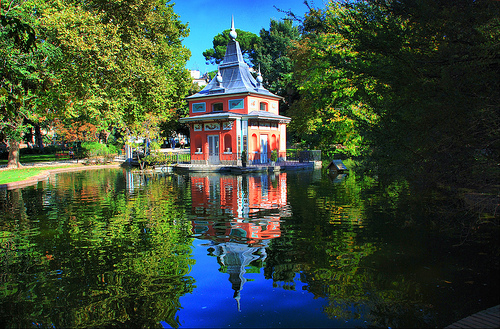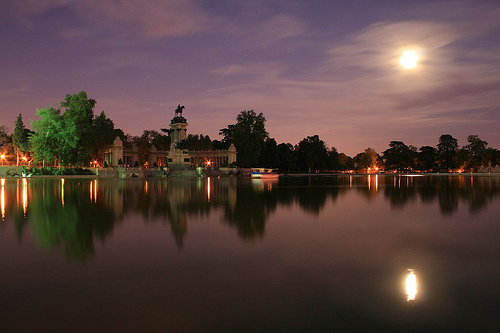

Subway: Retiro, Ibiza, Atoch
Open: daily

Parque del Retiro in Madrid was first opened in 1860. This extensive park was originally part of the Felipe IV Royal Palace. Considered as one of the main tourist attractions of the city, it houses numerous architectural, sculptural and landscape collections from the 17th to the 21st centuries, including the Monument to Alfonso XII, the Palacio de Cristal, the Estanque Grande, the Parterre, the Door of Felipe IV, the Royal Astronomical Observatory and the source of the Artichoke; and even earlier, such as the hermitage of San Pelayo and San Isidoro, of Romanesque origin. One of the most loved features of Parque del Retiro is a picturesque lake surrounded by a forest. Here you can hire raw boats. Magnificent Colonnade that overlooks the lake is topped by a statue of Spanish king Alfonso XII. Neoclassical Palacio (Neoclassical Palace) and Palacio de Cristal (Crystal Palace) often holds various art exhibits. Both palaces are located south of the Parque del Retiro lake. They were constructed in 1887 by an architect Velazquez Bosco.
Parque del Retiro was built in the first half of the seventeenth century within the landscape project developed for the Buen Retiro Palace, an old royal possession created by the Count-Duke of Olivares (1587-1645) for the enjoyment of Philip IV (1605-1665), who was his valid. Its use as an urban park dates back to 1767, the year in which Carlos III (1716-1788) allowed the entrance of the public for recreational purposes and, definitively, from 1868, when it was under the ownership of the Madrid City Council. Due to the destruction caused by the War of Independence (1808-1814), its current appearance is the result of interventions made in the nineteenth and twentieth centuries, although traces and original elements of the seventeenth and eighteenth centuries survive.
With an area of 118 hectares (1 180 000 m²), it belongs
administratively to the Retiro district, named after the park. It is
bounded on the north by the streets of Alcalá and O'Donnell, on the
south by the poet Esteban Villegas, on the west by Alfonso XII and
on the east by Menéndez Pelayo avenue.
Parque del Retiro is protected as an Asset of Cultural Interest
(BIC), a legal figure that every declaration of historical garden
has in the Spanish regulations. Within its limits live more than
19,000 trees, representing 167 species, including six specimens
included in the list of unique trees of the Community of Madrid.
Architecture
Monumental gates
The Retiro Park has seventeen entrances, conceived, to a large
extent, as monumental gates.
Gate of Felipe IV . Work of the architect Melchor de Bueras (? -
1692 ) is the oldest monumental gate preserved in Madrid. It was
made in 1680 inside Buen Retiro, to commemorate the arrival in the
city of Queen Maria Luisa de Orleans ( 1662 - 1689 ), first wife of
Carlos II ( 1661 - 1700 ). With the segregation suffered by the
gardens during the reign of Isabel II ( 1830 - 1904 ), from which
the Barrio de Los Jerónimos emerged, it was the object of a first
transfer. In 1922 it was moved to its current location, as the
entrance to the Parterre , and extended with two lateral openings,
according to Luis Bellido's project ( 1869 - 1955 ). It is located
on Alfonso XII Street , forming an axis with the Casón del Buen
Retiro .
Gate of Independence. It was built in 1817 as the main entrance of
the Casino de la Reina , a former royal possession located in the
Ronda de Toledo . In 1885 she was transferred to the Retiro under
the direction of José Urioste y Velada ( 1850 - 1909 ), architect
and urban planner who undertook deep reforms in Madrid, such as the
widening of the Gran Vía . It is of Doric order and is adorned in
its auction with two sculptural groups of Valeriano Salvatierra (
1788 - 1836 ). Located next to the Puerta de Alcalá, puts in contact
the Plaza de la Independencia , from which it takes its name, with
Paseo de México.
Gate of Spain . It was built in 1893 by the aforementioned Urioste ,
who used a scheme very similar to that of the Puerta de la
Independencia. It consists of three bays, delimited by four large
pedestals of Ionic order and closed by means of anartistic fence ,
made by Agustín Felipe Peró. It is located on Alfonso XII Street and
connects Calle de Antonio Maura with Estanque Grande , through the
Paseo de la Argentina (formerly known as the Estatuas).
Gate of Madrid. Located at the confluence of the streets of Alcalá
and O? 'Donnell, near the Aguirre Schools , it opens onto Paseo de
Fernán Núñez (or Paseo de Coches), the longest stretch of the
Retiro. It was designed with a great amplitude, in order to
facilitate the transit of vehicles. It is also due to Urioste, who
conceived two large pillars of quadrangular plan, decorated with
garlands and medallions with lion heads, in addition to an exempt
column of compound order, located between both. 34 It was
inaugurated in 1900 .
Gate of Hernani. In 1888 Urioste made a first gate, completely
metallic, which was replaced in 1943 by another more monumental,
from an initiative of the gardener Cecilio Rodríguez ( 1865 - 1953
), who in that same year built the gardens there. 37 It is located
on Calle de Alcalá and faces the Church of San Manuel and San Benito
.